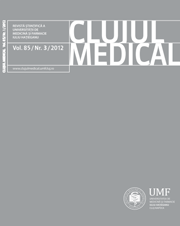Lipidic Profile and Metabolic Control in Type 1 Diabetic Children
Keywords:
diabetes, lipidic profile, hemoglobin A1c, C-peptideAbstract
Introduction. Type 1 diabetes mellitus is a progressive autoimmune disease characterized by destruction of β cells in the pancreatic islets. The concept of „metabolic memory”, i.e. diabetic vascular stress persists after glucose normalization, suggests the need for a good metabolic control. Dyslipidemia also plays a key role in inducing endothelial dysfunction, oxidative stress, inflammation and tissue remodeling in the diabetic patient.
The aims of this study were as follows: 1 - to determine the lipidic profile in DM children and healthy subjects; 2 - to investigate the correlation between C-peptide and years of evolution, to establish the metabolic control in DM patients; 3 - to establish the autoimmune pattern in DM patients who other other autoimmune diseases.
Methods and results. A control group of 36 healthy subjects with the mean age of 10.68±4.46, without any evidence of diabetes and 51 patients mean age of 11.65±4.10 diagnosed with type 1 DM were included in the study. We determined the metabolic parametrs such as lipidic profile, hemoglobin A 1c , C-peptide. The specific autoimmune antibodies were determined in 13 diabetic children who also had other autoimmune diseases. The lipidic profile showed a diabetic dyslipidemia (p<0.05). The level of the C-peptide in the diabetic group was 0.42±0.64, with a significat correlation coefficient between C-peptide and the years of evolution (p=0.002). The HbA 1c showed a poor metabolic control in the DM group, with a mean value of 9.51±1.87.
Conclusions. Metabolic control seems to be a pivotal pathway not only for the diabetic complications but also for the metabolic memory, therefore the possibility of „switching off” the metabolic memory could be an important strategy for the prevention of diabetic complications, in addition to a therapeutical intervention for diabetic dyslipidemia.
Downloads
Published
How to Cite
Issue
Section
License
The authors are required to transfer the copyright of the published paper to the journal. This is done by agreeing to sign the Copyright Assignment Form. Whenever the case, authors are also required to send permissions to reproduce material (such as illustrations) from the copyright holder.

The papers published in the journal are licensed under a Creative Commons Attribution-NonCommercial-NoDerivatives 4.0 International License.

